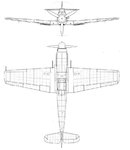Clay_Allison
Staff Sergeant
- 1,154
- Dec 24, 2008
You have to have a real pair of balls to hold your fire down to breath-smelling range, which is what you'd have to do to hit with bloody unguided rockets.Then use R4M rockets with HEAT warheads. No critical resources are required. Even a Me-109G6 can kill tanks (and heavy bombers too!) using this weapons system.

